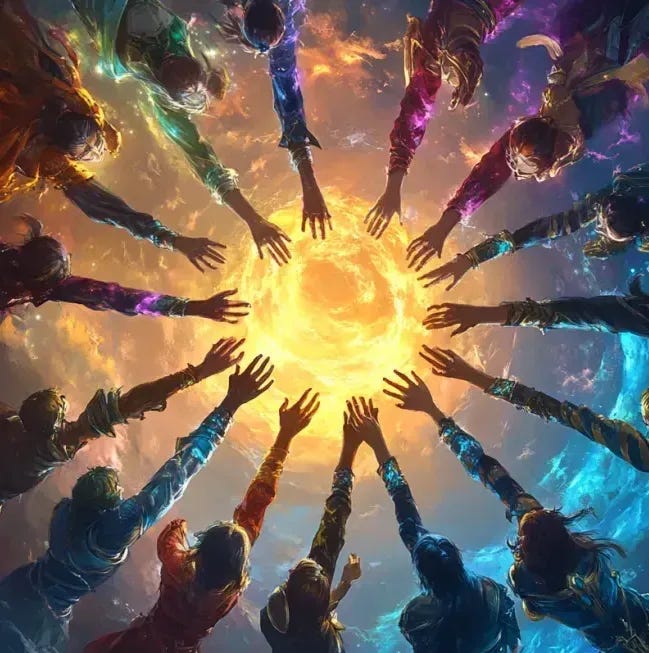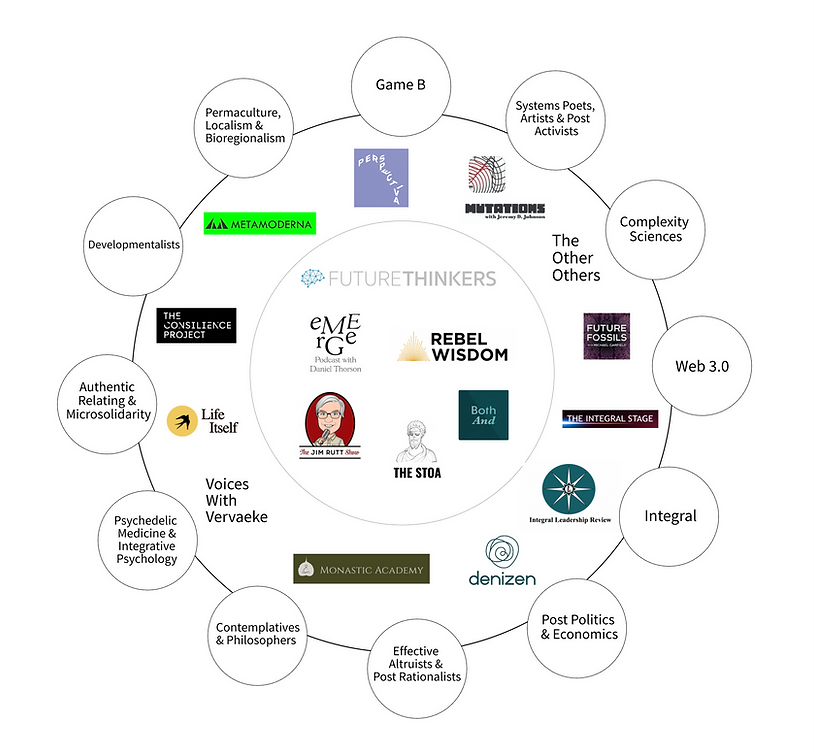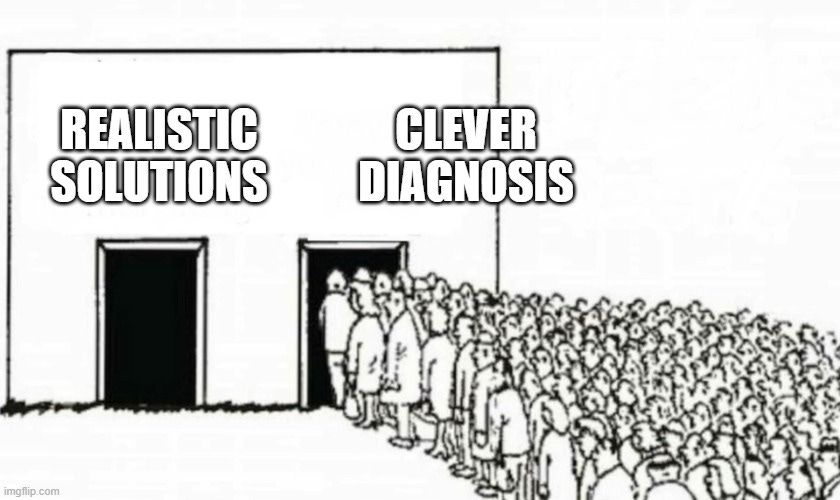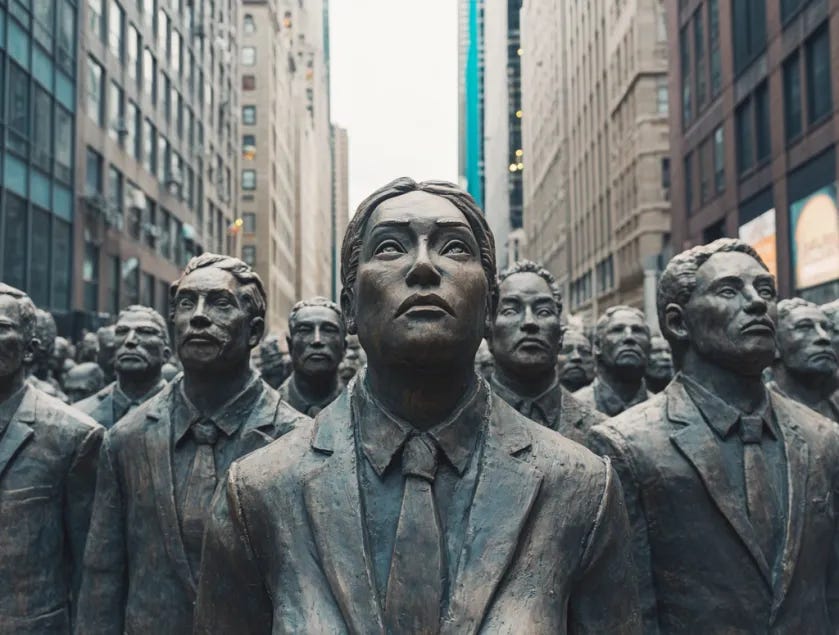Let's Build the World Wise Web
A Call to Community
A decade has now passed since the emergence of the Intellectual Dark Web (IDW). Figureheads like Jordan Peterson, Sam Harris and Eric Weinstein used their dizzying intellects to eloquently diagnose the deeper systemic issues with modern society. The problem was, raw intelligence is excellent at diagnosis and terrible at prescription. Too often the IDW simply believed that the cure for everything was for everyone to be as articulate and rational as them. Many of them failed to gain exit velocity from the gravitational pull of their own egos and crashed back to earth. The Intellectual Dark Web ended up being, well… a little too dark and intellectual.
The IDW was followed by the Liminal Web. This was a more diverse and holistic movement. It was less dominated by individual “galaxy brains” and more able to dance in the uncertainty of this transitional moment. The Liminal Web embraced the term metacrisis as a way of describing multiple systemic breakdowns that seemed to be happening simultaneously across society, politics, economics and nature.
The problem with the Liminal Web is that (as far as I can tell), it hasn’t had any significant impact on resolving the metacrisis. One reason is that, while the IDW was too left hemispheric, the Liminal Web was too right-hemispheric. It lacked agency and resources, so most movements never broke into wider societal awareness (how many of the groups above have you heard of?).
I’ve now met more than a hundred people loosely involved in the Liminal Web movement. Most of those conversations have started with either a desire to raise money or an ambitious plan to systemically change the world. The Liminal Web has been dragged into writing things like 10,000 word diagnostic white papers on the dangers of A.I…. Papers virtually nobody will read because nobody in these groups actually knows one of the key trigger-pullers in Silicon Valley. Please guys: no more diagnosis without prescriptions.
Writer and thinker Tao Te Turquoise coined the term World Wise Web to describe what is emerging now. What follows is my vision for what that might mean in practice.
The Liminal Web was wisdom seeking money and agency, the World Wise Web is money and agency seeking wisdom.
What is the World Wise Web?
“We need to drop the question of ‘What should we do?’ If we knew that, we would have done it. Instead, we can ask, ‘What kind of people do we need to become?’”
-Alexander Beiner
Our current crisis has been caused by the fact that we’ve reached the limits of collective human intelligence.1 I have almost no confidence that we can design a system superior to capitalism. We probably can’t think our way out of the metacrisis our intellects themselves created. From Jonestown to Pol Pot’s Cambodia, history is littered with attempts at engineered utopia that rapidly turn genocidal.
Meanwhile, there is a terracotta army of hundreds of thousands of petrified mid-career workers buried under every major city in the world. This isn’t some rarified elite, it’s the mass of dead or dying souls powering the dead or dying industries of the accelerating present. They’ve hit their “peak earning years” in roles they no longer love. They have been told to wait patiently for retirement, the salvation-God of capitalism. But they don’t have to spend the next thirty to forty years waiting for Godot, instead the right catalyst can transform them into powerful agents of positive change. They just lack a container for the chemical reaction that brings them back to life.
These containers will combine high-agency people with transformational wisdom networks. If more people overcome left-brain lock and find a professional niche guided by attractor intelligence, the whole system has a possibility of spontaneously resolving. The metacrisis was primarily caused by the limitations of human consciousness, so expanding individual wisdom must be a primary part of any solution. Put simply: a network that can evolve our individual consciousness can have a cascading positive butterfly effect on the collective.
The most visible members of the World Wise Web have been able to diagnose the bigger problems, but also help people evolve on an individual level. For example John Vervaeke has a deep sense for what he calls the “meaning crisis,” but also advocates for an individual ecology of wisdom practices. The likes of River Kenna and Daniel Thorson also have a deep feel for individual transformation.2
The primary feature of the World Wise Web will be a network of new community structures, rather than individual thought leadership. As Thich Nhat Hanh put it: “The next Buddha will be a Sangha [community].”
I’ve spent the last few years researching and joining other communities, mostly to see how and why they failed. Last year I launched my own network, The Leading Edge. While it’s obviously early days, here are seven features that have worked for us (**none of this is an advertisement, we’re currently closed to new members**).
Aimed at high-agency people. “High-agency” doesn’t necessarily mean wealthy (although that helps!), it means somebody who’s effective. These are people who promptly reply to emails and aren’t allergic to the mechanics of technology and finance. There are lots of left-hemispheric networking communities aimed at making you more successful, and lots of right-hemispheric communities aimed at making you more spiritual. I have found very few balanced in the middle. I’ll take an effective left-hemispheric person trying to change themselves over an ineffective right hemispheric person trying to change the world all day.
Intimate and private: In order to be resilient, I believe these networks need to be capped below Dunbar’s number of 150 people. This is approximately the maximum community size where everyone can know everyone else. Beyond that limit, other members are reduced down to labels, with the usual problematic consequences. Networks are defined by the strength of the loving connections between members. Because healing is intimate and some “woo” topics are still taboo, these communities should be private and ideally filled with intelligent, grounded peers. Many spiritual communities lack critical thinking faculties or lived experience at the higher levels of influence, so they can lapse into conspiracy thinking.
High-integrity content. This is even better than Kevin Kelly’s famous “1,000 true fans” model. In a small network you only need feed the curiosity of 150 people. Rather than try to compete with the misaligned incentives of an attention-capturing algo, you can directly cater to the needs and feedback of an audience you know personally. It’s a single fine-dining restaurant rather than a fast food chain. The Leading Edge has public content on Substack, YouTube, Spotify and Apple Podcasts. We also have private Zoom sessions, as well as IRL meetups. The private sessions are heavily biased towards experiences; there’s no shortage of static information content.
Membership revenue model. Our collective success has proven that people will pay for a community space that helps evolve their consciousness. As they should: it appears to be the central purpose of our existence. Wisdom has a greater influence on life satisfaction in older adulthood than health, socioeconomic status, financial situation, environment, or social engagement.3 Our revenue model is to charge ONLY for the container in the form of membership dues.
You get what you give. If I’ve learned one thing since starting the community, it’s what coach and founder Brian Whetten told me during our initial conversation on transformational relationships. About 10% of the value of any transformational “container” comes from the coach’s expertise, 30% from the relationship between coach and client and 60% from the commitment the client brings to the relationship. Applied to the whole community, members who joined Leading Edge looking to proactively meet others and bring their gifts to the group have received the most radical benefits. Passive or extractive people wouldn’t last long. It’s another reason it needs to be a closed community. When people ask me what value they will get from Leading Edge, I reply: “everyone else.”
Choose your own adventure. The Leading Edge offers members a high quality array of practices and practitioners, but has no predefined methods or outcomes. It seems like some things work better than others, but everyone’s ecology will ultimately be different.4 The entire point of finding your positive-sum niche is that it will hopefully be relatively unique to you. Hence you need a safe container for personal and professional experimentation, rather than a predefined course or path.
Digital first. In-person retreats based around healing and psychedelics are mostly a solved problem: if you want one there are lots of options available. I am more concerned with integrating peak experiences back into real life. While in-person meetups are critical, we also need communities that can support people on a daily basis. And for most of us with busy lives that means a digital platform. There is currently no ideal tech stack to connect these communities or manage communication within them. This is a significant market opportunity. The Leading Edge runs on a combination of WhatsApp, Zoom and email. My experiments with community management software have been very disappointing. Moreover, A.I. is seemingly still unable to make intuitive connections between members or the topics they discuss. It would also be great to have a rating and referral system for practices and practitioners each group has worked with.
In my experience, almost everyone wants to be a part of a community like this, but there aren’t enough people starting them. There are already millions of people with strong skillsets looking for more out of life, and their numbers are growing daily. Most people I now meet are starving to dig into deeper topics beyond markets and politics, but are wary of making the first move. The Leading Edge rapidly approached capacity within 6 months of launch. We’re roughly 50% current and former investors, 30% founders and 20% thinkers and healers. I expected to attract curious people, but the biggest surprise has been the humility and vulnerability of a group that is typically very “impressive.” Since we started, feedback from our members has generally been so positive it’s made me uncomfortable.
I can see my VC friends’ eyelids twitch when I tell them I don’t want to scale The Leading Edge. But the model is highly replicable. It is also a business that’s completely immune to disruption from A.I., while also helping its members evolve their own uniquely human edge over the LLMs.
These groups will also incubate an entirely new kind of leader. Each group needs a founder that has enough connections to bring a high-agency group together and then act as a gardener for the community. It’s likely that each founder’s vibe will attract a slightly different tribe. For example, Scott Britton’s Founder Satsang is a private community for “entrepreneurs who share a deep intention, interest, and commitment to exploring their inner space, consciousness, and/or spirituality while passionately creating in the world.” Alexander Beiner’s Kainos is a new community and content platform that aspires to “tell stories that help people make sense of the world and imagine new futures.”
It’s naive to believe that strangers will respect our desire for win-win outcomes in an increasing fragile win-lose economic system. I see too many well-intentioned “conscious capitalists” getting devoured by the ravenous predators in our collapsing fear-based paradigm. We are throwing adorable rabbits to the stoats instead of breeding dynamic hares that can outrun them. Wombs, walled-garden communities are therefore the necessary transition stage for whatever is emerging next. Capital and talent can seek positive-sum outcomes in a network centered on trust and love. Starting them and joining them is simply fun and can radically increase the amount of love and joy in our lives.
What is going to be needed is a mycelial network-of-networks supporting these communities:
If you know of other communities with similar characteristics, let us know.
If you know of technology, practitioners or resources that can help, please share them with us.
If you have iterations, criticisms or improvements on the above, please contact me or suggest in the comments.
Or even better: start your own version today.
This is the ultimate team-effort. I hope you can feel the excitement too.
River’s piece on metis in particular highlights the kind of sensitivity that’s going to define leadership in a transitional period.
The Accelerating Wisdom Series featured the gifts of Cedric Chin, Dr. Anne-Laure Le Cunff, Devin Martin, Allison Paradise, Dan Lawrence and Mona Sobhani, PhD. We emerged with 11 specific tools and wisdom practices.







Yes, Tom, let us weave a world wise web of interconnected communities. I’m working on this too by midwifing my own community called Wisdom Exchange.
But I’d like to underscore the important notion of balance - that it's not just what we’re building, but how we're building it that may make all the difference in the long run. This is where I believe the feminine quality of relationality is essential.
While we need vision and structure, we also need communal spaces where vulnerability and trust can be cultivated over time. Where people feel safe enough to see and be seen and everyone is committed to being changed in the interactions with others. Relational intelligence must not just be valued in theory, but embodied in practice.
The mature feminine spirit doesn’t push or demand. She invites. She listens. She attends to the space between us. And it is in this space the slow, tender, and relational work of coherence can emerge.
If we want our communities to endure, they must be rooted in this deeper way of belonging with one another and our surroundings. Let us not aim only for a network of competent minds, but a fabric of human hearts - strong enough to hold difference, resilient enough to repair rupture, and wise enough to move at the speed of trust...to respond to what the moment is asking of us.
This is the kind of world I believe we can co-create together. And I see your work, Tom, as adding a valuable piece to our collective endeavor.
Three cheers for the w(wise)w! Appreciated your connection to Metis, which definitely feels like a crucial ingredient(manifestation) of wisdom. A term I'd first heard of from Cynthia Bourgeault who describes the term as "the capacity to take skillful, decisive, appropriate action based on three-centered awareness (head, heart, and body)". https://wisdomwaypoints.org/resources/metis-teaching-by-cynthia-bourgeault/